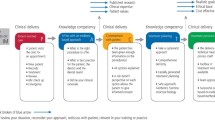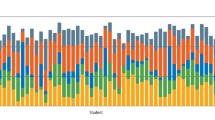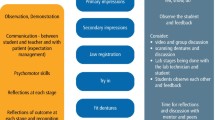Abstract
Aim To compare the treatment planning decisions made by undergraduate and postgraduate dental students before and after training on the use of the Dental Practicality Index (DPI).
Methodology One hundred and eight undergraduate and postgraduate dental students were randomly assigned to test (DPI) or control groups. The baseline knowledge was assessed in the first session; both groups were shown 15 clinical scenarios and asked to assign one of four treatment plan options (no treatment, simple treatment, complex treatment or extract). The most appropriate treatment plan had been agreed by a consensus panel of experienced dentists. The test group was then trained on the use of the DPI. In the second session, both groups were shown the same clinical scenarios again in a different order and asked to assign one of the four treatment plan options. Both groups completed the confidence questionnaire.
Results Training with the DPI improved the test (DPI) group mean scores from 9.1 in the first session to 10.3 out of 15 in the second session, which was a statistically significant difference (p = 0.005) when compared to the control group mean scores of 8.9 in the first session to 9.2 out of 15 in the second session. The mean confidence score of the students was 6.5 out of 10. There was no correlation between self-reported confidence scores of the students and the treatment planning result scores.
Conclusions The DPI aids in the systematic assessment and appropriate treatment planning of dental restorative problems by dental students.
Key points
-
A systematic approach to enhanced dental treatment planning.
-
Assists in identifying the complexities of dental treatment.
-
Provides a framework to aid patient discussion.
This is a preview of subscription content, access via your institution
Access options
Subscribe to this journal
Receive 24 print issues and online access
$259.00 per year
only $10.79 per issue
Buy this article
- Purchase on Springer Link
- Instant access to full article PDF
Prices may be subject to local taxes which are calculated during checkout


Similar content being viewed by others
References
Mindiola M J, Mickel A K, Sami C, Jones J J, Lalumandier J A, Nelson S S. Endodontic treatment in an American Indian population: a 10-year retrospective study. J Endod 2006; 32: 828-832.
General Dental Council. Preparing for practice: Dental team learning outcomes for registration (2015 revised edition). 2015. Available at https://www.gdc-uk.org/docs/default-source/quality-assurance/preparing-for-practice-%28revised-2015%29.pdf (accessed March 2021).
Tokede O, Walji M, Ramoni R et al. Treatment planning in dentistry using an electronic health record: implications for undergraduate education. Eur J Dent Educ 2013; DOI: 10.1111/j.1600-0579.2012.00759.x.
Ali K, Tredwin C, Kay E J, Slade A, Pooler J. Preparedness of dental graduates for foundation training: a qualitative study. Br Dent J 2014; 217: 145-149.
Ali K, Slade A, Kay E, Zahra D, Tredwin C. Preparedness of undergraduate dental students in the United Kingdom: a national study. Br Dent J 2017; 222: 472-477.
Patel J, Fox K, Grieveson B, Youngson C C. Undergraduate training as preparation for vocational training in England: a survey of vocational dental practitioners' and their trainers' views. Br Dent J 2006; Suppl: 9-15.
Curry M. The utilization of case difficulty assessment when determining endodontic referral. Chapel Hill: University of North Carolina, 2009. Masters Dissertation.
McDonald A V, Setchell D J. Developing a tooth restorability index. Dent Update 2005; 32: 343-348.
Curtis E K, Simon D C. Endodontic case difficulty assessment: the team approach. Gen Dent 1999; 47: 340-344.
Ree M H, Timmerman M F, Wasselink P R. An evaluation of the usefulness of the two endodontic case assessment forms by general dentists. Int Endod J 2003; 36: 545-555.
Royal College of Surgeons. Restorative Dentistry: Index of Treatment Need - Complexity Assessment. 2001. Available online at https://www.rcseng.ac.uk/-/media/files/rcs/fds/publications/complexityassessment.pdf (accessed March 2021).
Falcon H C, Richardson P, Shaw M J, Bulman J S, Smith B G N. Developing an index of restorative dental treatment need. Br Dent J 2001; 190: 479-486.
Townsend D. An audit of the Restorative Dentistry Index of Treatment Need Complexity Assessment. J Disabil Oral Health 2008; 9: 100-112.
Muthukrishnan A, Owens J, Bryant S, Dummer P M. Evaluation of a system for grading the complexity of root canal treatment. Br Dent J 2007; 202: E26.
Dawood A, Patel S. The Dental Practicality Index - assessing the restorability of teeth. Br Dent J 2017; 222: 755-758.
Tifooni A, Al-Nuaimi N, Dawood A, Mannocci F, Patel S. Validation of the effectiveness of the Dental Practicality Index in predicting the outcome of root canal retreatments. Int Endod J 2019; 52: 1403-1409.
Kirkpatrick D L, Kirkpatrick J D. Evaluating Training Programs: The Four Levels. 3rd ed. San Francisco: Berrett-Koehler Publishers, 2006.
Jones J, Hunter D. Qualitative Research: Consensus methods for medical and health services research. Br Med J 1995; 311: 376-380.
Gabel M J, Foster N L, Heidebrink J L. Validation of Consensus Panel Diagnosis in Dementia. Arch Neurol 2010; 67: 1506-1512.
Dental Protection. Continuum Series - Complexity. 2016. Available at https://www.dentalprotection.org/docs/librariesprovider4/dpl-publications/annual-review-2016.pdf (accessed March 2021).
Davis D A, Mazmanian P E, Fordis M, Van Harrison R, Thorpe K E, Perrier L. Accuracy of Physician Self-assessment Compared with Observed Measures of Competence. J Am Med Assoc 2006; 296: 1094-1102.
Stewart J, O'Halloran C, Barton J R, Singleton S J, Harrigan P, Spencer J. Clarifying the concepts of confidence and competence to produce appropriate self-evaluation measurement scales. Med Educ 2000; 34: 903-909.
McCaul L K, McHugh S, Saunders W P. The influence of speciality training and experience on decision making in endodontic diagnosis and treatment planning. Int Endod J 2001; 34: 594-606.
McCreery A M, Truelove E. Decision making in dentistry. Part I: A historical and methodological overview. J Prosthet Dent 1991; 65: 447-451.
McCreery A M, Truelove E. Decision making in dentistry. Part II: Clinical applications of decision methods. J Prosthet Dent 1991; 65: 575-585.
Alani A, Bishop K, Djemal S. The influence of speciality training, experience, discussion and reflection on decision making in modern restorative treatment planning. Br Dent J 2010; 210: E4.
Stacey D, Légaré F, Lewis K et al. Decision aids to help people who are facing health treatment or screening decisions. Cochrane Database Syst Rev 2017; DOI: 10.1002/14651858.CD001431.pub5.
Patel N, Patel S, Cotti E, Bardini G, Mannocci F. Unconscious Racial Bias May Affect Dentists' Clinical Decisions on Tooth Restorability: A Randomized Clinical Trial. JDR Clin Trans Res 2019; 4: 19-28
Author information
Authors and Affiliations
Corresponding author
Ethics declarations
The authors declare no conflicts of interest.
Rights and permissions
About this article
Cite this article
Hamer, S., Kanagasingam, S., Sonde, N. et al. The impact of the Dental Practicality Index on treatment planning. Br Dent J (2021). https://doi.org/10.1038/s41415-021-2948-5
Received:
Accepted:
Published:
DOI: https://doi.org/10.1038/s41415-021-2948-5



